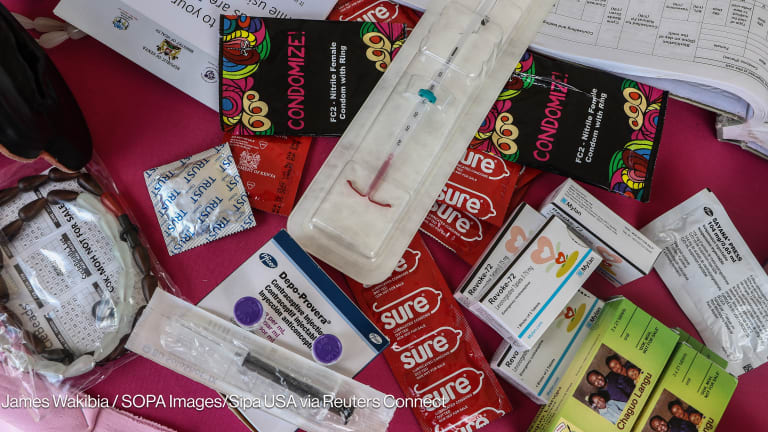
We are living in an era focused on women and girls — which is appropriate given the persistent and debilitating gaps in global access to education, health care, and economic opportunity between the genders. Yet, there is also a gap in complementary funding and research to engage men, which not only makes overall family planning objectives more elusive, but puts even greater stress and pressure on women to shoulder the burden of contraception on their own.
For now, the majority of family planning options are designed for women, and options for men are limited to condoms, vasectomies, and the withdrawal method of contraception. Although these options have not evolved in over a hundred years, this could soon change and cultural definitions of masculinity are evolving. World Vasectomy Day is proof that when provided thorough information through compelling stories, men will, in fact, participate in family planning, including opting for a vasectomy.
In response, DKT International and DKT Mexico, along with the National Center for Gender Equity and Reproductive Health and the Mexico City Ministry of Health, have joined forces with World Vasectomy Day to celebrate the event’s fifth anniversary. Led by more than 1,200 vasectomists in 50-plus countries, World Vasectomy Day is the largest male-focused family planning event ever, using creative media to dispel vasectomy myths, raise awareness, and promote broader positive masculinity. The government has embraced this anniversary in tandem with their 40th anniversary celebrations of Mexico’s Family Planning Program.
A common assumption is that investing limited family planning resources in male options provides a poor return-on-investment. In reality, not only is it good for family planning, but it is necessary for a healthy society. Research has found that when involved in family planning and sexual health programs, men are more likely to participate in household work and childcare, financial resources are more readily allocated for female contraceptives, and domestic violence decreases. Essentially, research has shown that bringing men into the family planning conversation actually increases overall contraceptive use while making broader and critical strides toward increasing gender equality.
Involving men in the broader conversation is key to sustainable family planning. Here are three tips for doing so.
1. Think big picture and start with the goal
World Vasectomy Day has learned that rather than opening conversations by asking men whether they want to get a vasectomy, shoot for the big-picture: How important is it that the quality of life of your children be better than your own? From there, conversations naturally cover the impact of large family sizes on ability to provide, and their desire to be part of the decision-making process. When vasectomies are seen as a tool to achieve desired family sizes and a way to care for the children they already have, men are extremely receptive.
2. Be provocative and make it fun
DKT has found that using dynamic, open, and fun social marketing techniques dramatically increases the uptake of the nonprofit condom brand, Prudence, in Mexico and other Latin American countries. Emphasizing that good sex and being responsible lovers are not mutually exclusive might be considered scandalous by some — but it works. Prudence is the most purchased condom brand in Mexico and Brazil. They have eroticized their condom messaging, celebrated sexuality, and used humorous vernacular without any medical jargon. DKT also gets creative in going beyond condom sales by offering resources to men for questions about sexual health through major events such as concerts, school functions, and health care fairs, and through its social media, Red-DKT call center, and Whatsapp mobile chat service.
3. Be open and connected, and create community
Asking men to get a vasectomy as part of a public ritual celebrated globally increases acceptance. What one will hesitate to do, a thousand-strong will not waver. This strategy transforms the common fear that a vasectomy leads to a loss of manhood into an increased sense of heroic purpose, all the while demystifying the procedure itself. As a communications-driven event, World Vasectomy Day uses videos and media products to dispel myths while cultivating community through shared stories of real patients before, during, and after their vasectomies. Since adopting the World Vasectomy Day program, Mexico has seen an 18.1 percent increase in vasectomy acceptance.
“I have six children. It was time for me to do this,” said Agustín Villa Martinez, a security guard, right after his procedure in Guadalajara, Mexico. “I had been thinking about it for a while, but I couldn’t bring myself to do it, because I thought it would hurt. I finally found the courage to do it. Now I feel free.”
Overlooking the power of men in increasing the use of family planning methods discounts a powerful agent for change in the world of gender equality and sexual and reproductive health and rights. But we know that engaging men is no small task. Beyond the 1,200 vasectomists, dozens of public health organizations spanning over 30 countries have coalesced to add their voice to this conversation and are working together to find a solution. This movement presents an opportunity to create unprecedented cooperation in the field.
By involving men in family planning programs, raising awareness of vasectomies as a simple and effective method, and celebrating the men who take part, we can truly shake up the stagnant growth in contraceptive use and global gender equality.
Join the Devex community and access more in-depth analysis, breaking news and business advice — and a host of other services — on international development, humanitarian aid and global health.









